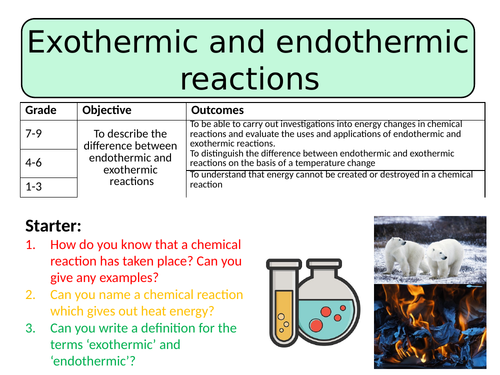
This lesson is designed for the NEW AQA Trilogy Chemistry GCSE, for more lessons designed to meet specification points for the NEW AQA Trilogy specifications for Biology, Chemistry and Physics please see my shop: https://www.tes.com/teaching-resources/shop/SWiftScience
This lesson begins with a description of an exothermic reaction, including examples such as the thermite reaction and the screaming jelly baby reaction. This includes link to videos to demonstrate the energy transfers which are taking place during these exothermic reactions.
Pupils are then asked to think>pair>share ideas about what an endothermic reaction might be and to come up with any examples if they can. Once students have had chance to discuss in groups, they can feedback to the class for a brief class discussion before the answer and examples are revealed using the PowerPoint presentation.
The next part of the lesson requires pupils to undertake an investigation into different reactions, they will identify whether three different chemical reactions are either endothermic or exothermic bu measuring the temperature change for each of them. Students should follow the instructions included and record their results in the table provided.
Students are now introduced to energy level diagrams to explain what is happening during an endothermic and exothermic reaction, they can sketch an example of each in their books for future lessons on energy profiles. The next part of the lesson will be a progress check, students should answer in their books and the work can be self-assessed using the answers provided.
The last part of the lesson is on uses of endothermic and exothermic reactions in products, students will each be given a card of information. They will need to share their information with others to complete a table in their books to describe each of the products, identify if it is an endothermic or exothermic reaction and evaluate the advantages and disadvantages.
The plenary task is for pupils to come up with their own product which uses either an endothermic or exothermic reaction.
Thank you, leave any questions in the comment section :)
Get this resource as part of a bundle and save up to 44%
A bundle is a package of resources grouped together to teach a particular topic, or a series of lessons, in one place.
Something went wrong, please try again later.
This resource hasn't been reviewed yet
To ensure quality for our reviews, only customers who have purchased this resource can review it
Report this resourceto let us know if it violates our terms and conditions.
Our customer service team will review your report and will be in touch.
